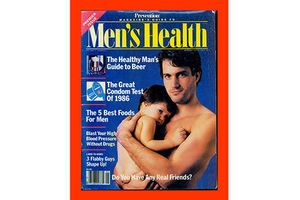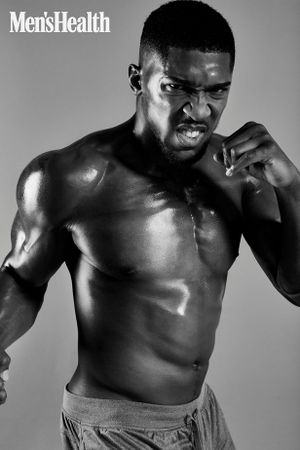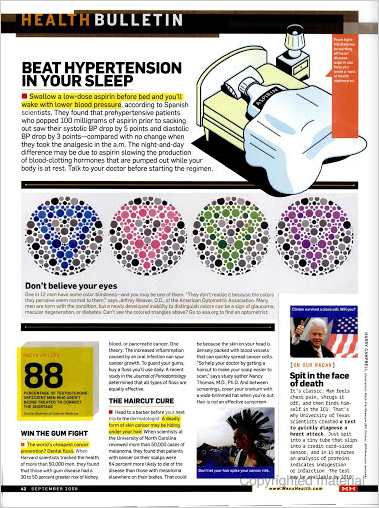Masculinity and Men's Health
Overview
The popular magazine Men’s Health contains representations of many aspects and ideas of masculinity. It is a platform that offers advice for males on subjects like health, fashion, fitness, and other lifestyle topics. While it’s popular among a varying demographic of men around the world, the magazine features many muscular models or public figures which promotes a stereotypical idea of a “man”.
History
Men’s Health started in the United States in 1987 (Alexander) as magazine that offered health information, and quickly evolved into a compilation of ideals for masculinity and what it should look like. It is now a global brand with 37 editions in 61 different countries, with a digital and social audience of 71 million people[1].
Influences
Body image
It is widely known that women’s magazines commonly use significant amounts of image retouching in order to portray an idealized version of beauty[2]. Likewise, the image of every Men’s Health cover model has also been carefully constructed through various professional lighting aids, photo editing software, and beauticians. These “muscular, lean, youthful and/or toned” models encourages men to “use muscularity and leanness as nominal markers of masculine embodiment”[3] .
Racialization
While a wide range of aesthetic and athletic men are featured in the magazine, it seems that white males are seen as the ideal type of men[3]. On the other hand, black males are shown as “spectacular, violent, and hyper-masculine”. Within a year’s span of 11 issues of the UK edition of Men’s Health, (from January/February 2010 to January/February 2011), it was found that white men were most prominently featured, while black men were the minority and South Asian men were virtually absent. On top of the disproportional representation of different races, instances of black men were sensationalized for their physicality, while instances of white men were “depicted as possessing the virtues of both mind and body”. In other words, it is implied that white men have brains and brawn but black men can only have brawn. As such, white male bodies are favoured for their overall idealistic traits of whiteness, which is racialized as being intelligent, successful, healthy, and quintessential. The intersectionality of race and masculinity leaves white models being presented as having more desirable traits.
Medicalization
Staying true to its roots, Men’s Health offers plenty of health advice surrounding popular questions men have about their health and fitness. However, the discussions of health occur under the discourse of masculinity, which puts the focus on advice that benefit an individual’s perceived masculinity instead of actual overall health [4].
Because Men’s Health is focussed on issues concerning the male body, it characterizes certain health and behavioural topics as specific for men. For example, one issue described risk-taking behaviour as an evolutionarily acquired biological habit that gave men “an edge over other hunger gatherers”, and helps them now in work, play, and sex. Such depictions of behavioural conditions normalizes and perpetuates hegemonic masculinity. On the same note, many narratives of daily health tips are laced with masculinist metaphors (for example, comparing LDL cholesterol levels to sport teams’ points-tally, or describing a battle with heart condition with boxing terms)[4]. These strategies also serve to construct masculinity by subtly hinting that men must have interest in sports and understand sport references.
On top of trying to engage male readers by appealing to them with masculine subjects and taglines, Men’s Health also medicalized many aspects of the male experience and his everyday life by regarding it as a medical issue. The magazine contains a subsection called Health Bulletin where suggestions for daily health advice backed up by “health experts” or scientific studies. These advice are often overly simplified versions of the truth, and presented without any opposing arguments or cautioning for its limitations [4].
Impacts
Masculinity is branded to consumers as a product that can be obtained through building a toned body or purchasing certain fashion items [5]. As a corporate magazine brand, Men’s Health earns profits through “banking on men’s anxieties about masculinity” [5] and constructing standards that are unattainable by any men [3].
References
- ↑ http://www.rodale.com/brands/iconic-brands/mens-health/
- ↑ http://idealbite.com/100-percent-of-what-you-see-in-fashion-magazines-is-retouched/
- ↑ 3.0 3.1 3.2 Lawrence, S. (2016). Racialising the “great man”: A Critical Race study of idealised male athletic bodies in Men’s Health magazine. International Review for the Sociology of Sport, 51(7), 777-799. doi:DOI: 10.1177/1012690214555347
- ↑ 4.0 4.1 4.2 Crawshaw, P. (2007). Governing the healthy male citizen: Men, masculinity and popular health in Men's Health magazine. Social Science & Medicine, 65(8), 1606-1618. doi:10.1016/j.socscimed.2007.05.026
- ↑ 5.0 5.1 Alexander, S. M. (2003). Stylish Hard Bodies: Branded Masculinity in Men's Health Magazine. Sociological Perspectives, 46(4), 535-554.



